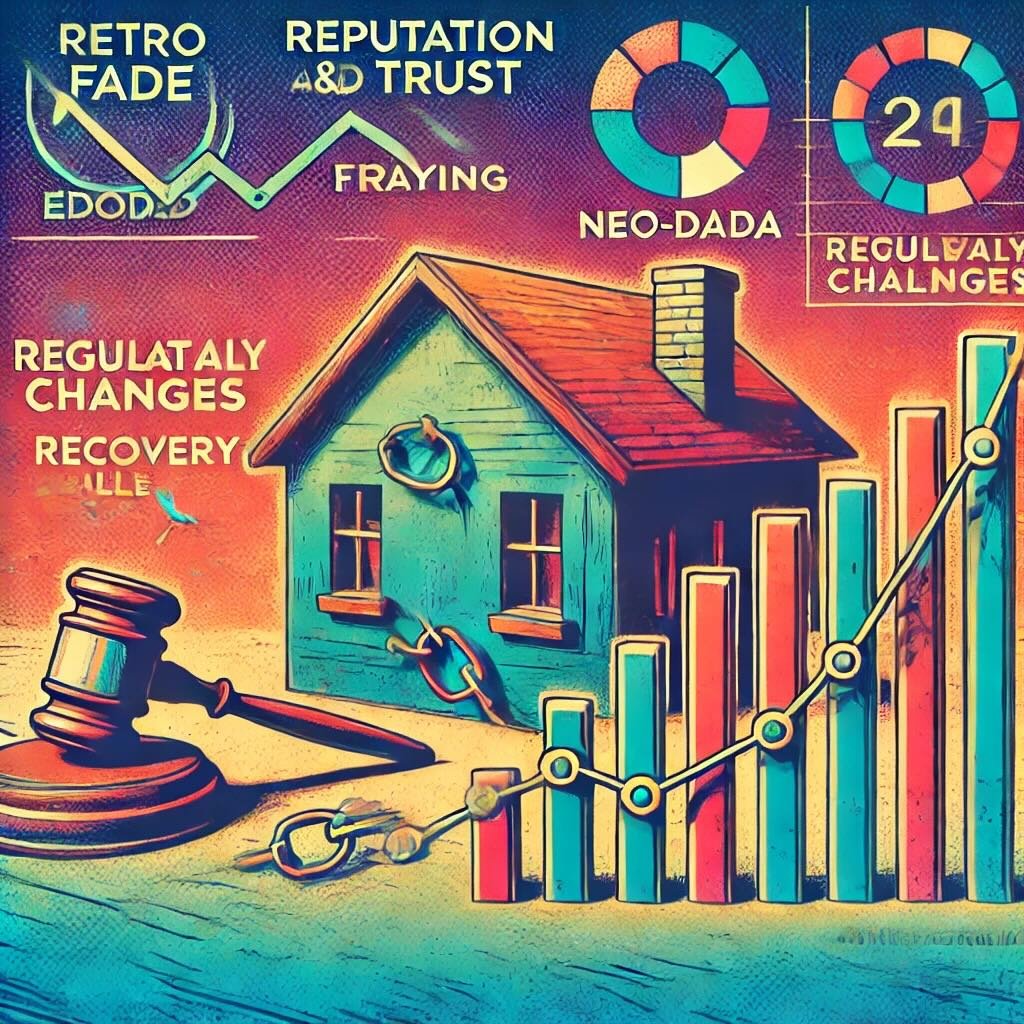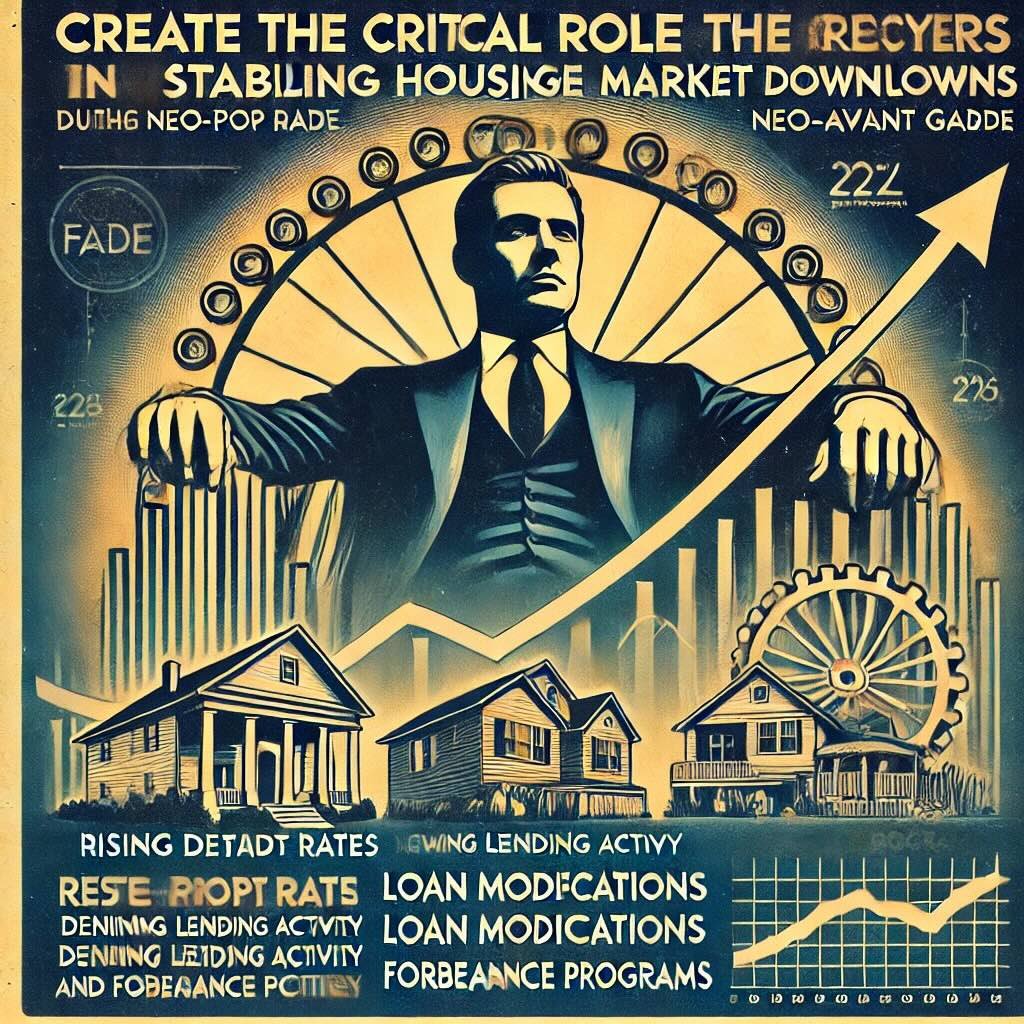Housing market downturns—those periods when the once-thriving real estate sector hits a wall—can send shockwaves through the economy. But what exactly triggers these downturns? Often, it’s a combination of factors: rising interest rates, an economic recession, or even an overinflated market that simply can’t sustain its growth. When these elements converge, the result can be a sharp decline in home prices, an increase in foreclosures, and a significant drop in new home sales. It’s a perfect storm that disrupts not just homeowners, but also the financial institutions that support the housing market.
source: CNBC on YouTube
In this scenario, mortgage lenders play a pivotal role. They’re the gatekeepers of homeownership, providing the loans that make buying a home possible. But in a downturn, their role becomes even more crucial—and complicated. As defaults rise and lending activity slows, lenders find themselves at the heart of the crisis, navigating the challenges of managing risk while supporting their borrowers. Their actions can either help stabilize the market or exacerbate the downturn. Understanding their role is key to understanding the broader dynamics of a housing market in distress.

Overview of Housing Market Downturns
We’ll explore how lenders are both influencers and responders in these challenging times. From managing rising default rates to adjusting lending standards, lenders’ decisions have far-reaching impacts on the market’s stability and recovery.
We’ll also look at the strategies lenders employ to mitigate the effects of a downturn—including loan modifications, forbearance programs, and partnerships with government initiatives. Additionally, we’ll examine the long-term consequences for lenders, such as changes in reputation, regulatory landscapes, and financial health. Finally, we’ll draw lessons from past downturns and discuss how lenders can better prepare for future challenges.

The Impact of a Downturn on Mortgage Lenders
Mortgage Lenders’ Role in Mitigating the Downturn
Loan Modification Programs
When a housing market downturn hits, one of the most powerful tools mortgage lenders have at their disposal is loan modification programs. These programs are designed to help struggling borrowers avoid foreclosure by making their mortgage payments more manageable. But how do they work? In essence, lenders adjust the terms of the loan—perhaps by lowering the interest rate, extending the loan term, or even reducing the principal balance. The goal is to lower monthly payments so that borrowers can stay in their homes.
Loan modifications aren’t just about keeping homeowners afloat, though. They’re also about protecting the lender’s investment. Foreclosures are expensive and time-consuming, often resulting in significant financial losses for the lender. By modifying loans, lenders can often recover more of their investment than they would through foreclosure. History has shown us the value of this approach. During the 2008 financial crisis, many lenders successfully used loan modifications to prevent widespread foreclosures, helping to stabilize the housing market and prevent further economic decline.
Forbearance and Payment Deferral
Another strategy that lenders use to mitigate the impact of a downturn is forbearance. Forbearance allows borrowers to temporarily reduce or pause their mortgage payments without facing immediate penalties. It’s a lifeline for homeowners who are facing temporary financial hardships, such as a job loss or unexpected medical expenses. The idea is to give borrowers some breathing room, allowing them time to get back on their feet.
But while forbearance offers immediate relief, it’s not without its challenges. For borrowers, the deferred payments don’t disappear—they still have to be paid back, often as a lump sum at the end of the forbearance period or added to the mortgage balance. This can create financial strain down the line, especially if the borrower’s situation hasn’t improved. For lenders, while forbearance helps avoid immediate defaults, it can create cash flow challenges and add complexity to loan management.
The pros and cons of forbearance make it a tool that needs to be used carefully. It’s not a permanent fix, but rather a temporary solution to help both borrowers and lenders navigate the rough waters of a downturn.
Working with Government Programs
During a downturn, mortgage lenders often collaborate with government programs designed to stabilize the housing market. These partnerships can be crucial in mitigating the worst effects of a crisis. A prime example of this is the Home Affordable Modification Program (HAMP), which was introduced in response to the 2008 financial crisis. HAMP provided incentives for lenders to modify loans and make them more affordable for borrowers, helping to prevent millions of foreclosures.
These government initiatives play a vital role in providing the framework and financial support necessary for large-scale loan modifications and other relief measures. By working together, lenders and the government can create solutions that are both effective and sustainable, helping to stabilize the housing market and support economic recovery. The success of these programs depends heavily on cooperation, with lenders playing a critical role in their implementation and execution.

Long-Term Consequences for Mortgage Lenders
Reputation and Trust
In the aftermath of a housing market downturn, a lender’s reputation can take a serious hit. When the economy is booming, it’s easy for lenders to maintain positive relationships with their customers. But when things go south—when foreclosures rise and borrowers struggle—trust can quickly erode. Homeowners may feel abandoned or mistreated, especially if their lender is slow to offer help or pushes too aggressively for repayment. The perception of being “just another number” can damage a lender’s reputation for years to come.
To navigate these choppy waters, lenders must be proactive in maintaining and rebuilding trust. This could mean offering transparent communication, providing flexible options for struggling borrowers, or even going above and beyond in customer service. A little empathy goes a long way. Lenders that demonstrate they’re committed to helping borrowers through tough times—rather than just protecting their bottom line—can preserve their reputation and even build stronger customer loyalty in the long run.
Regulatory Changes
Downturns often lead to a wave of new regulations aimed at preventing future crises. After all, when a market crash happens, the public and government alike start asking tough questions: “How did this happen?” and “What can we do to stop it from happening again?” The mortgage industry, in particular, tends to face increased scrutiny, leading to tighter regulations and stricter oversight.
For lenders, these regulatory changes can be a double-edged sword. On one hand, they’re designed to protect the market and consumers, which can help prevent the kinds of risky lending practices that lead to downturns in the first place. On the other hand, increased regulation can add layers of complexity to a lender’s operations, requiring more compliance efforts, reporting, and possibly even reshaping business models. The long-term impact can be significant, potentially limiting a lender’s flexibility and increasing operational costs.
Financial Health and Recovery
The financial toll of a downturn on mortgage lenders can be severe. With rising defaults, reduced lending activity, and increased operational costs, lenders often see their profits shrink—or disappear entirely. The road to recovery can be long and challenging, requiring lenders to take a hard look at their financial health and make strategic decisions to rebuild.
Recovery strategies might include diversification, where lenders expand their portfolios beyond traditional mortgage products to include other types of loans or financial services. This can help mitigate risk and create new revenue streams. Additionally, focusing on maintaining strong capital reserves and managing liquidity can provide a cushion against future downturns, ensuring that the lender is better prepared to weather economic storms.

Case Studies: Lender Responses in Past Downturns
The 2008 Financial Crisis
The 2008 financial crisis was a watershed moment for the housing market—and mortgage lenders found themselves at the epicenter of the storm. When the housing bubble burst, defaults skyrocketed, and the market was flooded with foreclosures. Major lenders, many of whom had been riding high on subprime mortgage lending, suddenly faced unprecedented losses.
In response, lenders had to act quickly. Some implemented sweeping loan modification programs, aiming to keep homeowners in their properties and stave off the flood of foreclosures. Others worked to stabilize their own financial positions by tightening lending standards and shoring up capital reserves. However, not all strategies were successful. The sheer scale of the crisis overwhelmed many efforts, leading to significant financial strain and, in some cases, the collapse of major financial institutions.
Looking back, the effectiveness of these strategies was mixed. While some lenders managed to navigate the crisis and emerge stronger, others were left reeling. The 2008 crisis underscored the importance of proactive risk management and the dangers of unchecked lending practices, leaving a lasting impact on the industry.
The Early 1990s Recession
The early 1990s brought another challenging period for the housing market, though on a smaller scale than 2008. During this time, a combination of high interest rates, economic recession, and a previous boom in real estate led to a housing downturn. Mortgage lenders found themselves dealing with a rise in defaults and a decline in property values, similar to the challenges faced during other downturns.
Lenders during the early ‘90s downturn often took a conservative approach. Many tightened their lending standards and focused on reducing their exposure to risky loans. Some lenders also experimented with early forms of loan modifications and short sales to mitigate losses. The lessons learned from this period were clear: cautious lending practices and maintaining strong underwriting standards are key to weathering economic turbulence.
This recession also highlighted the importance of government intervention and support for the housing market. Programs that encouraged refinancing and provided relief for struggling homeowners helped stabilize the market, setting the stage for recovery. These experiences informed the strategies used in later downturns, including the 2008 crisis.
The COVID-19 Pandemic
The COVID-19 pandemic brought with it an unprecedented economic shock, and the housing market was no exception. In a matter of weeks, the world was turned upside down— and mortgage lenders had to adapt quickly to the new reality. The pandemic led to widespread job losses and financial instability, creating a real risk of a housing market collapse.
However, this time, lenders were more prepared. Drawing on lessons from past crises, they swiftly implemented forbearance programs, allowing borrowers to temporarily pause or reduce their mortgage payments. This move, combined with historically low interest rates, helped prevent a wave of foreclosures and kept the housing market afloat.
Government intervention played a crucial role as well. Programs like the CARES Act provided financial relief to millions of Americans, while the Federal Reserve’s actions helped stabilize the broader economy. Lenders worked closely with these initiatives, recognizing that collaboration was key to mitigating the impact of the pandemic on the housing market.

Preparing for Future Downturns
Risk Management Strategies
In the ever-changing world of real estate, one thing is certain: downturns will happen. The question is, how prepared are mortgage lenders for the next one? Effective risk management is the cornerstone of surviving and thriving during these challenging times. Lenders need to be proactive, not reactive, in assessing and managing the risks they face. This means closely monitoring economic indicators, staying ahead of market trends, and continuously evaluating their loan portfolios for potential vulnerabilities.
One of the most critical aspects of risk management is maintaining liquidity and capital reserves. During a downturn, cash flow can quickly become a major issue, especially when defaults start to rise. By ensuring they have adequate reserves, lenders can weather the storm, absorb shocks, and continue operations without having to resort to drastic measures like selling off assets at a loss. It’s about having a cushion to fall back on— and making sure that cushion is big enough to handle the unexpected.
Innovative Lending Practices
As the saying goes, necessity is the mother of invention. Downturns, while challenging, also present an opportunity for lenders to explore new and innovative lending practices that can offer greater stability. For instance, dynamic pricing models that adjust loan terms based on real-time market conditions could help mitigate risks associated with fluctuating interest rates and economic uncertainty. These practices allow lenders to be more flexible and responsive, adapting to changes as they happen rather than being caught off guard.
Technology and data analytics are also game-changers in this space. By leveraging big data, lenders can gain deeper insights into borrower behavior, market trends, and potential risks. Predictive analytics can help identify borrowers who might be at risk of default, allowing lenders to take proactive measures before problems escalate. The potential of these tools is enormous, enabling lenders to fine-tune their lending practices, improve decision-making, and ultimately, create a more resilient lending environment.
Building Resilient Borrower Relationships
At the heart of every mortgage is a relationship between the lender and the borrower. In times of economic downturn, these relationships are put to the test. But they can also be a source of strength. By fostering strong, resilient relationships with borrowers, lenders can help navigate the challenges together. How? Through proactive communication, transparency, and a commitment to supporting borrowers through tough times.
Encouraging financial literacy is a key part of this. When borrowers understand the terms of their loans, the risks involved, and the options available to them, they’re better equipped to manage their finances effectively. This reduces the likelihood of defaults and fosters a sense of trust between the borrower and lender. It’s about being partners in the process, not just parties to a transaction.
Proactive communication is also crucial. Lenders who reach out to borrowers at the first sign of trouble—rather than waiting for missed payments—can often find solutions that work for both parties. Whether it’s offering a loan modification, forbearance, or simply providing financial counseling, these early interventions can make all the difference in preventing a bad situation from getting worse.

Conclusion
Mortgage lenders are at the heart of the housing market, and their role becomes even more critical during downturns. From navigating rising default rates and declining lending activity to implementing loan modifications and forbearance programs, lenders are key players in stabilizing the market during tough times. They have the power to influence the trajectory of a downturn through the strategies they employ—whether that’s tightening lending standards to manage risk or collaborating with government programs to support struggling homeowners. Their actions ripple through the economy, affecting not just the housing market but the financial well-being of millions.
Final Thoughts
As we look to the future, it’s clear that proactive strategies and resilience are essential for both lenders and borrowers. Lenders must be prepared to face the challenges of the next downturn with innovative approaches, strong risk management, and a commitment to maintaining trust with their customers. It’s not just about surviving the storm—it’s about emerging stronger on the other side.
For borrowers, understanding the role of mortgage lenders and the tools available to them during a downturn can make all the difference. Knowledge is power, and being informed about how lenders operate can help homeowners make better decisions and navigate financial difficulties more effectively.
The call to action is clear: lenders must continue to innovate, embrace new technologies, and build stronger relationships with borrowers to prepare for whatever challenges the future may hold. By doing so, they can help create a more stable and resilient housing market—one that’s better equipped to weather the ups and downs of economic cycles. The road ahead may be uncertain, but with the right strategies in place, both lenders and borrowers can face it with confidence.
Important Information
Comprehensive Investment Disclaimer:
All content provided on this website (including but not limited to portfolio ideas, fund analyses, investment strategies, commentary on market conditions, and discussions regarding leverage) is strictly for educational, informational, and illustrative purposes only. The information does not constitute financial, investment, tax, accounting, or legal advice. Opinions, strategies, and ideas presented herein represent personal perspectives, are based on independent research and publicly available information, and do not necessarily reflect the views or official positions of any third-party organizations, institutions, or affiliates.
Investing in financial markets inherently carries substantial risks, including but not limited to market volatility, economic uncertainties, geopolitical developments, and liquidity risks. You must be fully aware that there is always the potential for partial or total loss of your principal investment. Additionally, the use of leverage or leveraged financial products significantly increases risk exposure by amplifying both potential gains and potential losses, and thus is not appropriate or advisable for all investors. Using leverage may result in losing more than your initial invested capital, incurring margin calls, experiencing substantial interest costs, or suffering severe financial distress.
Past performance indicators, including historical data, backtesting results, and hypothetical scenarios, should never be viewed as guarantees or reliable predictions of future performance. Any examples provided are purely hypothetical and intended only for illustration purposes. Performance benchmarks, such as market indexes mentioned on this site, are theoretical and are not directly investable. While diligent efforts are made to provide accurate and current information, “Picture Perfect Portfolios” does not warrant, represent, or guarantee the accuracy, completeness, or timeliness of any information provided. Errors, inaccuracies, or outdated information may exist.
Users of this website are strongly encouraged to independently verify all information, conduct comprehensive research and due diligence, and engage with qualified financial, investment, tax, or legal professionals before making any investment or financial decisions. The responsibility for making informed investment decisions rests entirely with the individual. “Picture Perfect Portfolios” explicitly disclaims all liability for any direct, indirect, incidental, special, consequential, or other losses or damages incurred, financial or otherwise, arising out of reliance upon, or use of, any content or information presented on this website.
By accessing, reading, and utilizing the content on this website, you expressly acknowledge, understand, accept, and agree to abide by these terms and conditions. Please consult the full and detailed disclaimer available elsewhere on this website for further clarification and additional important disclosures. Read the complete disclaimer here.





